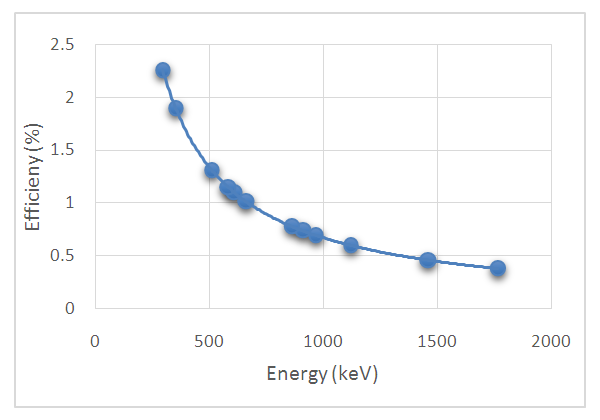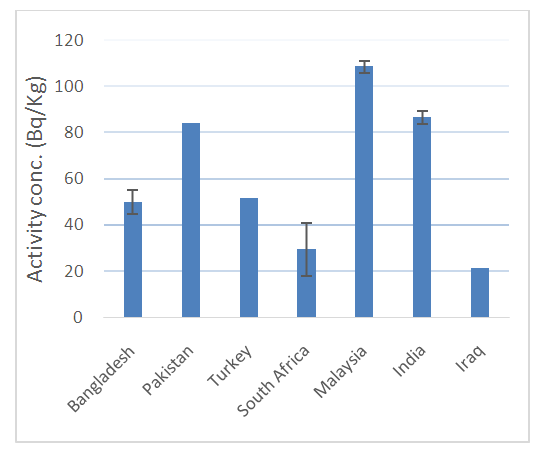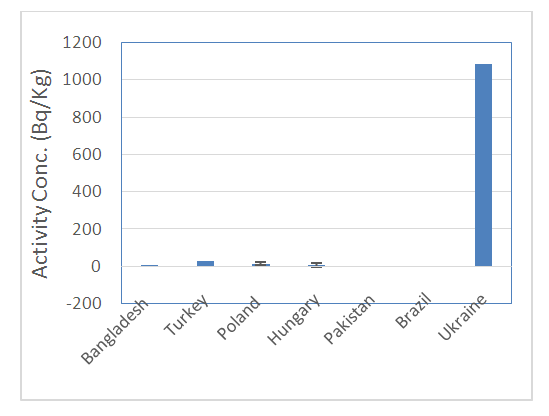-
Paper Information
- Paper Submission
-
Journal Information
- About This Journal
- Editorial Board
- Current Issue
- Archive
- Author Guidelines
- Contact Us
Journal of Nuclear and Particle Physics
p-ISSN: 2167-6895 e-ISSN: 2167-6909
2020; 10(2): 31-35
doi:10.5923/j.jnpp.20201002.02
Received: July 15, 2020; Accepted: August 16, 2020; Published: August 29, 2020

Estimation of Activity Concentration of 232Th, 137Cs, and 40K in Soil in Bangladesh
Md. Moshiur Rahman , Tangina Khanam , Rubina Rahman
Department of Physics, Jahangirnagar University, Savar, Dhaka, Bangladesh
Correspondence to: Md. Moshiur Rahman , Department of Physics, Jahangirnagar University, Savar, Dhaka, Bangladesh.
| Email: |  |
Copyright © 2020 The Author(s). Published by Scientific & Academic Publishing.
This work is licensed under the Creative Commons Attribution International License (CC BY).
http://creativecommons.org/licenses/by/4.0/

This study deals with the assessment of natural radioactivity due to 232Th, 137Cs and 40K in soil samples in Bangladesh. High purity germanium (HPGe) detector based spectrometry system coupled with Multi Channel Analyzer (MCA) was used to obtained gamma-ray spectra. The spectra of all the measurements were saved in the MCA software. MAESTRO for Windows Model A65-B32 containing a software version 5.30 enabled us to obtain the total and net areas under the photo-peaks of the specific gamma-ray energies of interest. The contents of 232Th was determined using 510 keV, 583.14 keV & 860 keV of 208Tl and 911.07 keV & 969.19 keV of 228Ac. The 40K and 137Cs are estimated from 1460 and 662 keV respectively. The mean concentrations of 232Th, 40K and 137Cs were found to be 49.964 ± 5.153, 719.469 ± 47.893 and 7.759 ± 0.717 Bq/kg respectively. The obtained results are compared with the reported and recommended values from other countries and international organizations respectively. The results indicates that there was no fallout in Bangladesh due to nuclear accident like Three Mile Island (1978), Chernobyl (1986) and Fukushima Daiichi (2011) and the low level activity of 137Cs fallout pauses hardly any radiation hazard to the population. The widespread distribution of 40K in soil provides principal contribution to radioactivity in the environment. The study provide a base line data for further study of radiation hazards in Bangladesh in comparison with world average as well as to study the impact of nuclear accident throughout the world.
Keywords: MCA, HPGe, Natural radioactivity, Effective dose, Radionuclides etc
Cite this paper: Md. Moshiur Rahman , Tangina Khanam , Rubina Rahman , Estimation of Activity Concentration of 232Th, 137Cs, and 40K in Soil in Bangladesh, Journal of Nuclear and Particle Physics, Vol. 10 No. 2, 2020, pp. 31-35. doi: 10.5923/j.jnpp.20201002.02.
1. Introduction
- The environmental contamination with radioactivity may cause of human activities like uses of radioisotope for treatment/diagnosis, nuclear weapons and nuclear energy [1,2]. The nuclear reactor accident in Three Mile Island (1978), Chernobyl (1986) and Fukushima Daiichi (2011) also may cause of pervasive of radionuclide into environment and subsequent fallout into soil because of rainfall. In most cases the radioactive wastes are stored with safety criterion but the comprehensive fallout from nuclear weapons/nuclear accident is the potential threat for human being and is the subject of further research. Soil contamination with radionuclide like 137Cs and 232Th may be elevated from fallout of nuclear accident or testing of nuclear weapons. Both of these radionuclide have introduced a substantial amount of radiation into the environment and have caused environmental contamination for long time since their half-lives are long [3]. Such a long lived radionuclides in soil easily uptakes by plants and redistributed in food chains, which would be a potential threat if the radiation exposure exceeds the permissible limit and may be environmental threat to public health [4]. It has been predicted that, 79% of the radiation to which individuals are exposed is from natural sources, and remaining 21% are from man-made activities [5]. According to UNSCEAR (2000), an average radiation dose of 0.29 mSvyr-1 is received worldwide via ingestion of natural radionuclides of 238U and 232Th series and 40K during habitual consumption of food and water. This small amounts of ingested or inhaled radioactivity may produce a damaging effect and can become a serious health risk [6]. In addition natural and artificial radioactivity in building materials (bricks and clay) and soils preeminent the potential health hazards for the dwelling population [7-11]. In spite of having difficulties, the nuclear power industry is expanding to contribute power consumption and to reduce the consumption of fossil fuel to restrict the global warming. With ever increasing population, the uses of radioisotopes in medicine also are sky rocketing. Thus the release of radioactive wastes from medicine, industry and research, nuclear weapon testing and radioactive wastes from nuclear reactors into environment are increasing [12]. Since the route of release of radionuclides from nuclear industry is inevitable and cause of environmental contamination, its assessment is important for remediation for radiological safety. The natural occurring nuclides of the uranium, thorium and actinium series have to be invaluable indicators of dynamic process in the aquatic environment [13] and a framework against which the introduction of their alpha emitting nuclides can be assessed. For the assessment of effective dose equivalent to the population of Bangladesh, it is necessary to estimate the concentration of various radionuclides in the environment, entering in the various organs of the body as a function of time.
2. Materials and Methods
- Sample Collection and PreparationThe soil samples were collected from 8 different locations at AECD Campus at depths of 0-2 inch and 3-5 inch. About 300 gm of each samples from each depth and location was collected in separate plastic container with proper identification code. The depths were so chosen to obtain samples from the surface to plough line for the qualitative and quantitative determination of radioactivity. The samples were dried until they attained constant weight. Each dried samples were grounded to ensure homogeneity and transferred to sealable plastic container, marked individually with identification parameters. Then the prepared samples were ready for counting. Standards (Al2O3 based 226Ra and IAEA Soil-6) were also prepared in the same way.Gamma SpectrometryThe energy calibration of the HPGe detector [14] was performed by using known gamma point sources like 137Cs and 60Co with energies 662 keV, 1172 keV and 1332 keV. The energies response linearly with channel numbers and the MCA was adjusted to suitable channel numbers by entering the energies of the calibration source in keV into the MCA to convert all 4096 channels to respective energies. For quantitative determination of the radionuclides in unknown sample, the detector efficiency which relates the number of pulses counted to the number of gamma photons incident on the face of the detector was adjusted [15]. The energies spread in multi-channel analyzer were adjusted to 0-3366 keV energy over 16384 channels. The energies response linearly with channel numbers and the MCA was adjusted to suitable channel numbers by entering the energies of the calibration source in keV into the MCA to convert all channels to respective energies. The detection efficiencies were calculated using Al2O3 based 226Ra standard. The content of 226Ra was measured using γ-energy of 295.21 keV & 351.92 keV for 214Pb and 609.31 keV, 1120.3 keV & 1764 keV for 214Bi. The contents of 232Th was determined using 510 keV, 583.14 keV & 860 keV of 208Tl and 911.07 keV & 969.19 keV of 228Ac. The 40K and 137Cs are estimated from 1460 and 662 keV respectively. The daughter products of 226Ra and 232Th in all samples were omitted from our consideration because either their activities were less than the minimum detectable limit or their peaks were of bad shapes.
 | Figure 1. Efficiency Calibration curve |
 | (1) |
 | (2) |
3. Results and Discussion
- The natural radioactivity concentrations (average) of 137Cs, 232Th and 40K in different soil samples of Bangladesh are presented in figure-2. For the nuclides of 232Th, measurement were taken on the 911 keV & 967 keV peaks of 228Ac and 583 keV, 511 keV and 860 keV peaks of 208Tl. It is observed that the activity of 228Ac varies from 64.452 ± 6.448 to 83.645 ± 7.079 Bq kg-1 with an average of 71.434 ± 6.655 Bq kg-1. The concentration of 208Tl (583, 510 and 860 keV) were found to be in the range from 25.858 ± 3.674 to 31.805 ± 3.684 Bqkg-1 with an average of 28.494 ± 3.651 Bq kg-1.
 | Figure 2. Average Activity conc. of Th, K and Cs |
 | Figure 3. Variation of conc. in distinct years |
 | Figure 4. Comparison of K conc. with world average |
 | Figure 5. Comparison of Th conc. with world average |
 | Figure 6(a). Comparison of Cs conc. with world average |
 | Figure 6(b). Comparison of Cs conc. with world average |
4. Conclusions
- The natural radioactivity in soil samples were estimated by the gamma spectroscopy and the average radioactivity concentrations of 232Th, 40K and 137Cs in soils are found to be 49.964 ± 5.153, 719.469 ± 47.893 and 7.759 ± 0.717 Bq/kg respectively. The 137Cs activity in soil samples was found to be constant over twenty years and is almost negligible. Therefore, it may be concluded that there was no fallout in Bangladesh due to nuclear accident like Three Mile Island (1978), Chernobyl (1986) and Fukushima Daiichi (2011). Till now low level activity of 137Cs fallout pauses hardly any radiation hazard to the population. The widespread distribution of 40K in soil provides principal contribution to radioactivity in the environment. The results provide a base line data for further study of radiation hazards in Bangladesh in comparison with world average as well as to study the impact of nuclear accident throughout the world.
 Abstract
Abstract Reference
Reference Full-Text PDF
Full-Text PDF Full-text HTML
Full-text HTML